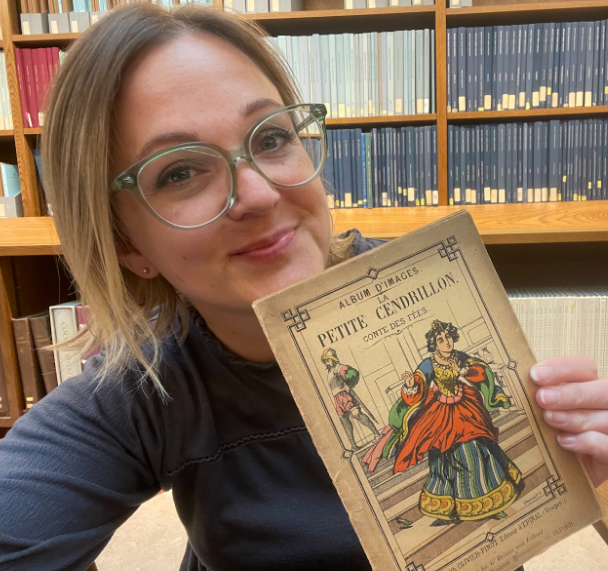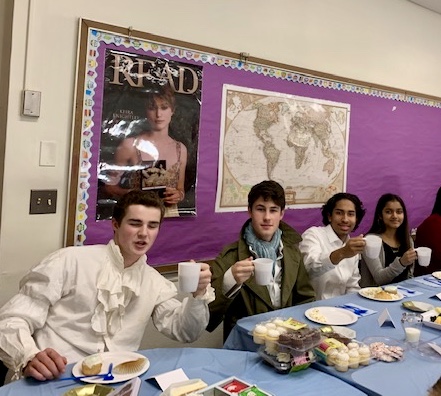“Travel changes you. As you move through this life and this world you change things slightly, you leave marks behind, however small. And in return, life – and travel – leaves marks on you. Most of the time, those marks – on your body or on your heart – are beautiful. Often, though, they hurt.” – Anthony Bourdain
Once upon a time, an elementary school librarian became a Fund for Teachers Fellow, and her fairy tale dreams became a reality. It really did feel like a whirlwind fairy tale. Back in January of 2023, a friend of mine reached out to me about working together on a FFT grant. I was hesitant at first, because life felt very busy at the time, but after only a little convincing I agreed. However, the application’s due date was around the corner, so we got to work right away!
Hailey Wansick and I are both librarians, but she is a librarian at a high school, and I’m at an elementary school. We decided on fairy tales, because fairy tales and their lessons are for everyone. They have spanned hundreds of years, and they continue to enchant generations as retellings and fractured fairy tales are consistently being published today. After some research, we decided to focus on England, Germany, and France. We wanted to create a deeper understanding of fairy tale origins and their importance, promote excitement for and interest in reading, and enhance our library collections. We wanted to learn more about fairy tale pioneers like Madame d’Aulnoy, Charles Perrault, and the Brothers Grimm. When I got the email that said our proposal had been selected, and I was officially a Fellow, I ran to my principal’s office with tears in my eyes!



A few months later, Hailey and I flew into France, ready to start our adventure. Over the following two weeks, we traveled from France to Germany and then to England. We walked the streets of Paris and the Gardens of Versailles. We visited towns along the Fairy Tale Route in Germany. One of our favorite stops was GRIMMWELT Kassel in Kassel, Germany. GRIMMWELT Kassel is a Brothers Grimm museum. We learned so much about the Brothers Grimm, their inspirations, and their life works. Our last stop was England. Before the trip, I had been in contact with the University of Oxford’s Bodleian Libraries as well as the British Library. We were able to go through the process of acquiring library cards and gained access to their special collections. Being able to see and touch rare fairy tale books was this librarian’s dream come true! My fellowship made me realize I have so much more to learn about fairy tales! I still feel this way. There is such a rich and extensive history surrounding fairy tales.
After I got back home it was time to work on bringing the magic to my students. Fairy Tale Week was born. I collaborated with my specials team on making Fairy Tale Week a reality. Students would have fairy tale-themed lessons in all of their specials classes: music, PE, art, STEM, and library. We would have a dress-up day on the Friday of that week, because who doesn’t want to dress up like a fairy tale character or creature? In November 2023 we had our first Fairy Tale Week, and it was a magical success. Students drew castles, dragons, and king and queen portraits. They played fairy tale games, and created their own fractured fairy tales. They participated in a musical storytelling and a Disney sing-a-long. They also competed in fairy tale STEM-related challenges.
The week had been like a dream, but as I read stories to all of my classes that week, I realized many of my students were unfamiliar with the original fairy tales. To address this gap, this year I spent more time reading classic fairy tales to all of my students in preparation for Fairy Tale Week. Our second annual Fairy Tale Week was in January 2025, and it was once again filled with fairy tale-themed lessons in all of the specials classes. Fairy Tale Friday was especially fun! Classes gathered in the gym for enrichment during specials, where they heard the story of Rumplestiltskin, played a kingdom-defending game, and showed off their wonderful costumes. Both Fairy Tale Weeks wouldn’t have been as magical without my team. With my whole team on board, we were able to create a special week for all of our students! Recently, I have had teachers express a desire to have additional grades collaborate with us in the future. It will be interesting to see how Fairy Tale Week evolves.



I’m so grateful to have been awarded this grant and to be able to call myself a Fund for Teachers Fellow. This experience has created in me a lifelong interest in fairy tales and a desire to share them with my students. I was able to present, along with Hailey Wansick, about our fellowship at the 2024 Oklahoma Library Association conference as well as during an Oklahoma School Librarians (OKSL) Learning Module over the summer. It was an honor to share with others about this special professional development opportunity and encourage them to apply! People often ask me what my favorite fairy tale is, and I have such a difficult time answering this question, because I know I have so many more fairy tales to read and discover! However, if I have to choose, Little Red Riding Hood is a forever favorite. National Tell a Fairy Tale Day is on February 26th, and I encourage everyone to take this opportunity to share with others a tale as old as time!


































 “Enabling our students to succeed, despite where they come from, was oneof the major reasons I used a Fund for Teachers grant to attend the “Teaching with Poverty in Mind” and “Tools for Maximum Engagement seminars” said Brittany after completing her fellowship.“Our students come from a background of poverty and we want them to have maximum engagement in their academics.”
“Enabling our students to succeed, despite where they come from, was oneof the major reasons I used a Fund for Teachers grant to attend the “Teaching with Poverty in Mind” and “Tools for Maximum Engagement seminars” said Brittany after completing her fellowship.“Our students come from a background of poverty and we want them to have maximum engagement in their academics.”